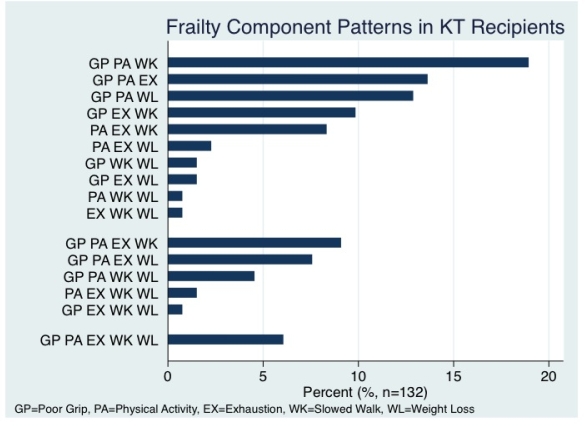Frailty in KT Recipients of All Ages.
Johns Hopkins, Baltimore.
Meeting: 2016 American Transplant Congress
Abstract number: 153
Keywords: Kidney transplantation, Mortality
Session Information
Session Name: Concurrent Session: Older and High Risk Kidney Transplant Recipients/Donors
Session Type: Concurrent Session
Date: Sunday, June 12, 2016
Session Time: 4:30pm-6:00pm
 Presentation Time: 4:30pm-4:42pm
Presentation Time: 4:30pm-4:42pm
Location: Ballroom A
Background: Among KT recipients, frailty increases the risk of DGF, early hospital readmission and mortality. While it is clear that frail KT recipients represent a high risk group, the correlates of frailty and whether there are high-risk patterns of the frailty components is unclear. Which components of frailty are relevant to KT recipients of all ages is unclear.
Methods: 693 KT recipients were enrolled in a prospective cohort study (12/2008-10/2015) at Johns Hopkins Hospital. The Fried frailty phenotype (5 components: weight loss, poor grip strength, low activity, exhaustion and slowed walk speed), activities of daily living (ADL)/ instrumental activities of daily living (IADL) disability, Centers for Epidemiologic Studied-Depression Scale (CESD), education and health related quality of life (HRQOL) were measured at evaluation and KT admission. Age, sex, race, obesity status, smoking status, time on dialysis, cause of ESRD and donor type were also ascertained from the medical record. We used adjusted multinomial regression to identify frailty correlates and adjusted Cox proportional hazards models to identified which pattern of the 5 components was associated with mortality.
Results: Among KT recipients 19.1% were frail. The only factors associated with frailty status were older age (≥65) (2.21, 95%CI:1.22-4.01), IADL disability (3.34, 95%CI:3.28-21.27), CESD depressive symptoms (8.35, 95%CI:3.28-21.27), <high school education (2.89, 95% CI:1.22-6.83) and excellent/very good HRQOL (2.89, 95%CI:1.22-6.83). The most common pattern of the 5 components was poor grip strength, low physical activity and slowed walk speed (18.9%). KT recipients with exhaustion and slowed walking speed (HR=2.41, 95%CI:1.17-5.01, P=0.02) and poor grip strength, exhaustion and slowed walking speed (HR=2.48, 95%CI:1.09-5.64, P=0.02) were at increased mortality risk.

Conclusion: Frailty is common in KT recipients of all ages. While age contributed to the burden of frailty, factors that are often not measured as part of clinical practice, HRQOL, ADL/IADL disability and depressive symptoms, were strong correlates of frailty. The components of frailty may need to be redefined or updated to capture risk in adults of all ages undergoing KT.
CITATION INFORMATION: McAdams-DeMarco M, Ying H, Olorundare I, King E, Segev D. Frailty in KT Recipients of All Ages. Am J Transplant. 2016;16 (suppl 3).
To cite this abstract in AMA style:
McAdams-DeMarco M, Ying H, Olorundare I, King E, Segev D. Frailty in KT Recipients of All Ages. [abstract]. Am J Transplant. 2016; 16 (suppl 3). https://atcmeetingabstracts.com/abstract/frailty-in-kt-recipients-of-all-ages/. Accessed December 21, 2025.« Back to 2016 American Transplant Congress
